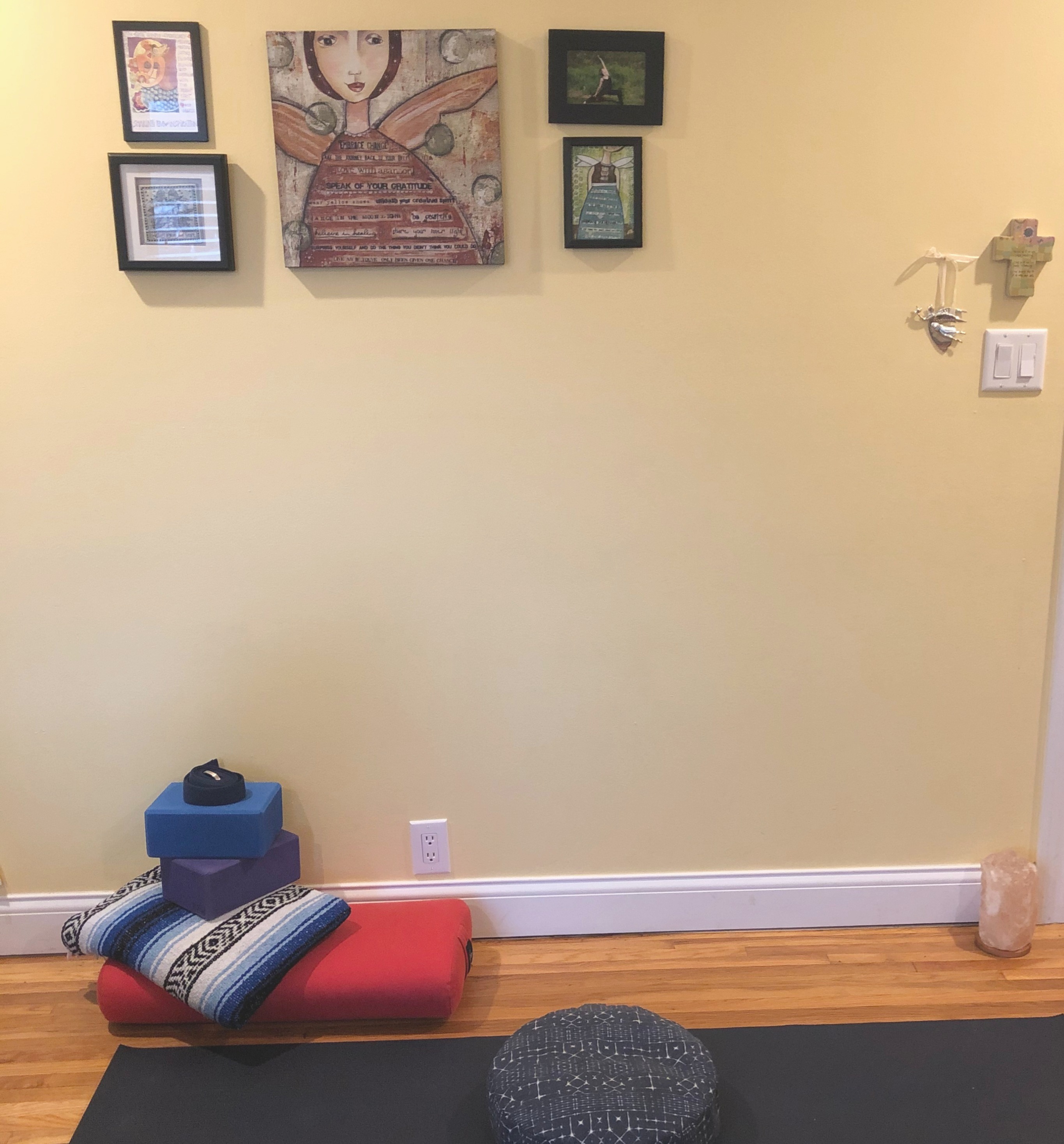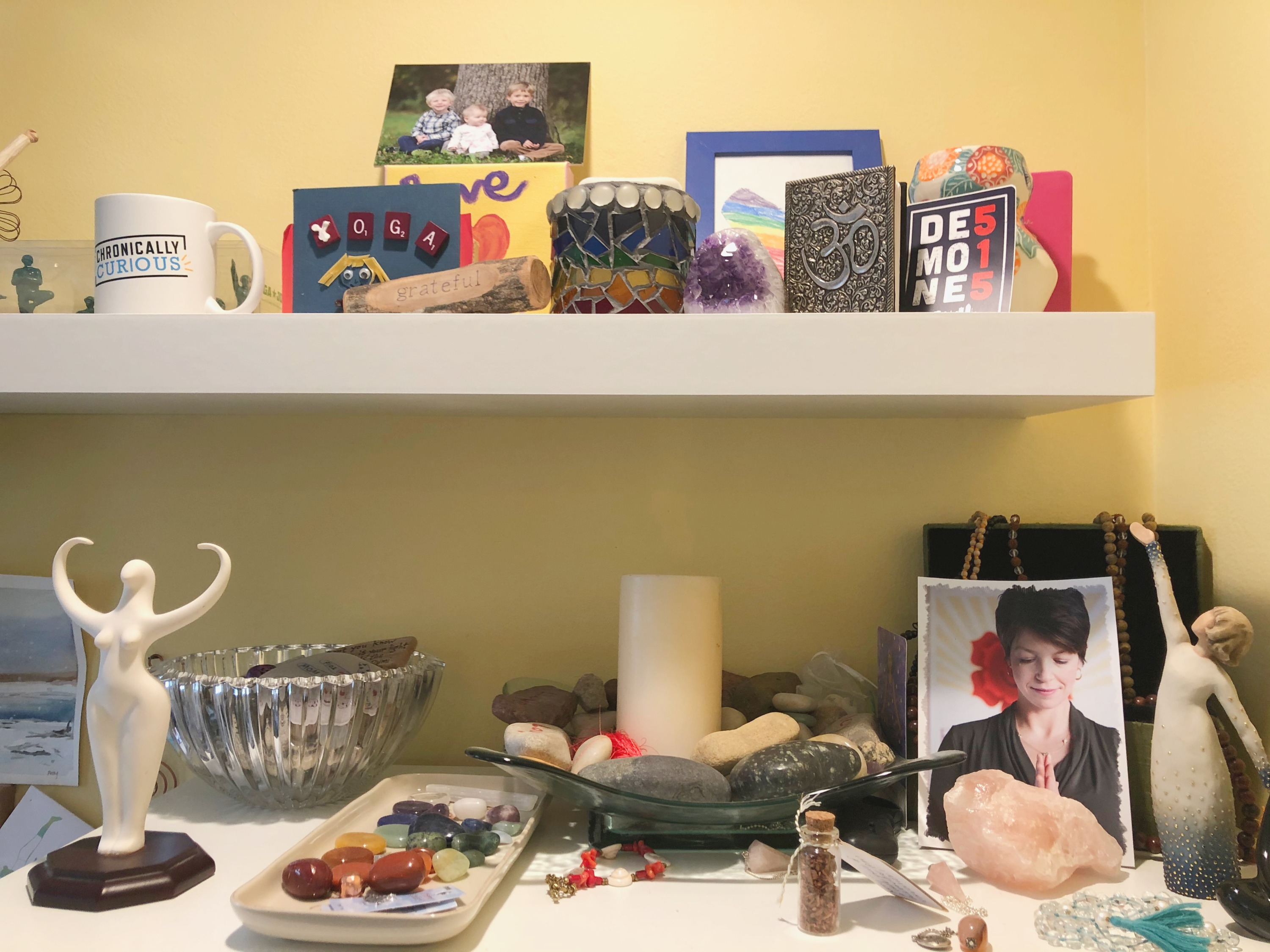We have entered a time in history when we are asked to stay home to flatten the curve and help slow down the spread of the coronavirus. Our favorite restaurants have closed. Our children cannot go to school and learn with their friends. Many of us are asked to work from home and our favorite fitness centers and yoga studios have shut down to help keep us safe. We are asked to shelter in and stay home. We have never been through a pandemic before and we don’t know how long this will last or when our cherished gathering places will open again for all of us to meet and connect face-to-face. This is hard. It is challenging all of us and we don’t know when it will end.
Maybe now more than ever, we are invited to practice at home. To create a space that feels soothing and calm to our mind and body. A sacred space filled with items that bring us joy and gratitude. A place to sit, turn inward, move and fill our bodies with prana, life force.
If you have never practiced at home before, it may seem really scary to roll out your mat or sit on your meditation cushion. Maybe you don’t know where to start or what to do. I get it. Even after 20 years of teaching yoga, I still prefer to be lead by a teacher. I still prefer to follow along and do what the teacher is asking of me. I don’t want to have to think about my next pose or sequencing it “just right.” But now is a wonderful time to let go of our image of perfection and cultivate a practice that is “just right” for you – right here, right now.
The practice of yoga was not created to be an outward practice. It is a practice inviting each of us to travel inward. To feel, experience, understand and get curious about what is happening inside of our mind and body. It is a practice helping prana move freely within us, keeping us healthy and well in mind and body. It is a practice to help us connect to our Higher Self and have right-relationship with our Self.
So how do we do this? It is simple and difficult at the same time. It requires a commitment and it is very helpful if your practice is consistent. You show up day after day allowing the practice to wash over you.
Environment (Things to consider):

- Room and Floor: Find a space that is large enough for a yoga mat and any other equipment you might use. Remove any unnecessary distractions. It is helpful to practice in a room that is aired out frequently and cleaned regularly.
- Lighting: Natural light is ideal with overhead lighting that has a dimmer switch or lamps that can be turned on instead of an overhead florescent light.
- Props: It is helpful to have a yoga mat when practicing asanas. Additional props to consider include blocks, belt, blankets and bolsters. If you do not have these items at home, you can still practice and find alternative items. For example, you can use a scarf instead of a yoga belt or books instead of blocks. I order my props online at HuggerMugger.
- Plants: Living plants create a pleasant backdrop and remind you of nature. They also remove toxins from the air.
- Art or photos: Pictures of scenes or people that bring you joy and gratitude can help create a sacred space you look forward to being in.
- Candles or essential oils: Candles can purify the air and essential oils help shift your mood and emotional well-being. I prefer doTERRA essential oils and especially like the yoga blends (anchor, align and arise).
- Crystals, stones, mala beads, statues, etc.: Items you cherish and bring healing to your mind and body can be placed near your mat. These items may have been purchased on a trip or given to you by a friend. Choose carefully and try not to clutter your space with items.

Intention (Your why)
- Before you begin: When you start a practice, it can be helpful to pause, listen and feel. Asking yourself questions to help you get curious about what you need. How do you feel, what thoughts are running through your mind, where do you feel tightness or constriction, am I experiencing any pain?
- Set an intention: This may be simple or complex. It is helpful if you are specific. For example, you may want to increase your energy level. This type of practice will look and feel very different than if your intention is to feel grounded and calm. Maybe your practice is to bring more balance and stability to your thoughts, actions and words. Maybe your practice is for others and our world. Whatever it is, begin your practice with an intention. This helps you create a relationship with yourself. Turning inward is what sets a yogi apart from someone who is performing the yoga postures.
- Take refuge: Your yoga practice is anchored in prana. The quality of your practice is important. It is helpful if you set up a ritual. Let go of the mechanical feel of poses and allow your practice to flow organically. Bring asana, pranayama and meditation into the experience. Stay curious and witness what occurs within.
What’s next? (Self guided or Teacher led)
- Teacher led: Even though you are home, you can find many wonderful teachers offering classes online via zoom, Facebook Live, YouTube or through memberships. It can be hard to know where to start. I encourage you to ask around and experience a variety of teachers offering free classes. Check out who they are and what experience they have teaching. It may take a few classes to really get a feel for what you like and what feels good to you. Trust your instincts and allow yourself to enjoy a variety of different teachers. You will discover that finding a yoga and meditation teacher takes some time. Give yourself some grace and continue to explore different styles before you quite and decide yoga is not for you. You can learn about teachers on Yoga Alliance or well known online resources like Yoga International, Yoga Journal, Glo and Gaiam. A local teacher in your hometown may currently be offering classes online, especially now that in-person classes are temporarily stopped. Support local teachers and be a part of your community. You are welcome to practice online with me on my “Mary McCarthy Yoga” YouTube channel or join me for a LIVE class via zoom every week. Details are listed on my website www.mary-mccarthy.com
- Self led: Determining your intention helps determine how you want to sequence a yoga practice. Many resources are available for ideas or suggestions online and in books. You can incorporate pranayama and meditation before, during or after your asana practice depending on your intention. When you begin your practice, turn inward and listen to what you need right now. Our bodies hold the answers and can help guide us into a practice anchored in prana.
Making space for your practice (also known as sadhana) at home takes effort. Give yourself some grace as you step onto your mat or take a seat. Have faith in your practice and maintain a focus on staying balanced. Your self effort does lead to greater freedom. I truly believe Yoga is the practice that increases our capacity to tolerate the intolerable. We are steady in the midst of unsteadiness. It is the gift of resilience.

